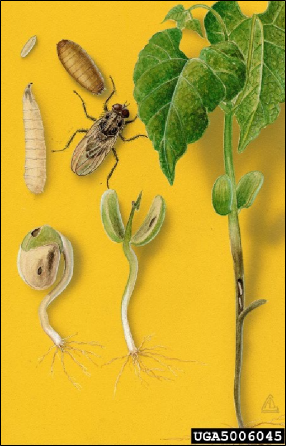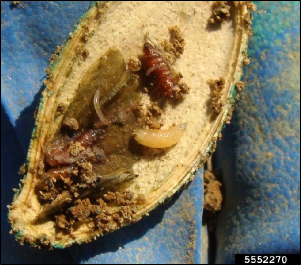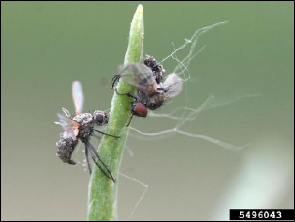Cabbage and Seedcorn Maggot
ID
444-231 (ENTO-495NP)
Introduction
The cabbage maggot, Delia radicum, and the seedcorn maggot, Delia platura, belong to the fly family Anthomyiidae in the order Diptera. The genus Delia consists of several economically important agricultural pests. Related species include the similar onion maggot (D. antiqua), turnip root fly (D. floralis), and root-maggot fly (D. planipalpis).
Description
Larval cabbage and seedcorn maggots are virtually indistinguishable from one another in the field. The larvae of both species are white, tapered maggots with a blunt, broad end to the abdomen (Fig. 1). Fully mature larvae measure about 7.6 mm (0.3 inch) long. The adults are small (about 6 mm or 0.25 inch), grayish flies that resemble a slender house fly (Fig.1). The pupae are reddish-brown oblong capsules found in the soil.
Life History
Both D. radicum and D. platura have life cycles consisting of the egg, larval, pupal, and adult stages. Adults of both species typically emerge from the soil and begin laying eggs in April. Pupae of the last generation serve as the overwintering stage.
Female cabbage maggot flies lay eggs on the lower stems of young host seedlings or in nearby cracks in the soil. Within a few days the eggs hatch and the tiny maggots burrow down to the roots and begin feeding. Pupation occurs three to four weeks later, followed by the emergence of second-generation adults in another week. Several generations of cabbage maggots may occur before early July, but the first generation is the most destructive.

The life cycle of the seedcorn maggot is similar to the cabbage maggot, but female seedcorn maggot flies prefer to lay eggs in moist, freshly- tilled soil enriched with organic matter. Soil fertilized with animal manure is highly attractive. Seedcorn maggot eggs hatch within a few days and the larvae feed on decaying organic matter or on the germinating seeds of wild or crop plants (Fig. 2). Seedcorn maggots are known to be highly attracted to odors produced by germinating seeds.

Common Host Plants
Cabbage maggots can be very destructive pests of early season plantings of cole crops, including cabbage, cauliflower, broccoli, and brussels sprouts. Additional hosts include beet, radish, turnip, and celery.
Seedcorn maggots attack asparagus, cabbage, turnip, radish, onion, beet, spinach, potato, and sprouting corn seeds. Seedcorn maggots can also be very damaging to beans, peas, and new plantings of alfalfa.
Distribution
Seedcorn maggot and cabbage maggot, like other species of Delia, are found throughout the United States.
Damage
Cabbage maggots attack feeder roots and tunnel into taproots. Root crops such as radish and turnip with feeding tunnels and visible brown streaks are unmarketable. Lower leaves of infested cabbage and other cole crops often turn yellow and plant growth may be stunted. Secondary infections of blackleg and bacterial soft rot diseases typically accompany cabbage maggot infestation.
Seedcorn maggots feed on sprouting seeds of numerous field and garden crops. Unlike cabbage maggots, seedcorn maggots typically do not infest plantings beyond the early seedling stage. In corn, seedcorn maggots bore into the germinating seed, often killing it. Failure of corn seedlings to emerge is usually the first indication of a seedcorn maggot infestation.
Cool temperatures and wet conditions that delay germination during spring plantings can greatly increase the damage caused by both the cabbage and seedcorn maggots.
Control
Control measures for cabbage maggot, seedcorn maggot, and related species typically rely on the preventive use of soil-applied granular insecticides or insecticidal seed treatments at planting. Fields and gardens with a history of seedcorn maggot problems may benefit from the application of an insecticidal seed treatment at planting. See the Virginia Pest Management Guides for current chemical control recommendations for seedcorn maggot, cabbage maggot, and other species of Delia. Consult Home Grounds and Animals (VCE 456-018) for home gardens, the Mid-Atlantic Commercial Vegetable Recommendations (VCE 456-420) for row crops, and Field Crops (VCE 456-016) for field corn. As with all pesticides, follow the label instructions carefully with regards to rates and precautions.
A baited wire trap procedure for sampling seedcorn maggot in rotational field corn is detailed in the Virginia Pest Management Guide for Field Crops (VCE 456-016).
In small plantings and home gardens, mechanical barriers such as tar paper, plastic mulch, and plant collars placed at the base of host plants have been used with some success to prevent egg-laying by adult cabbage maggots. Ground beetles and other beneficial insect predators may provide some degree of control in most years, but they may not be sufficient in cool, wet springs. Because subsequent generations of seedcorn maggots are not as damaging as the first generation, replanting damaged crops is usually a safe option.
Remarks
Each spring, seedcorn maggot flies are infected with a type of insect-killing fungi. The infected flies seek out stems of small grains, dogwood twigs, or other flowers that allow them to climb to a high point. The flies settle on the plant where they eventually die as a result of the fungal infection (Fig. 3). These infected flies are sometimes seen stuck to windows, glued there by the fungus.

Revised
Theresa A. Dellinger, March 18, 2022.
Virginia Cooperative Extension materials are available for public use, reprint, or citation without further permission, provided the use includes credit to the author and to Virginia Cooperative Extension, Virginia Tech, and Virginia State University.
Virginia Cooperative Extension is a partnership of Virginia Tech, Virginia State University, the U.S. Department of Agriculture (USDA), and local governments, and is an equal opportunity employer. For the full non-discrimination statement, please visit ext.vt.edu/accessibility.
Publication Date
March 25, 2022



